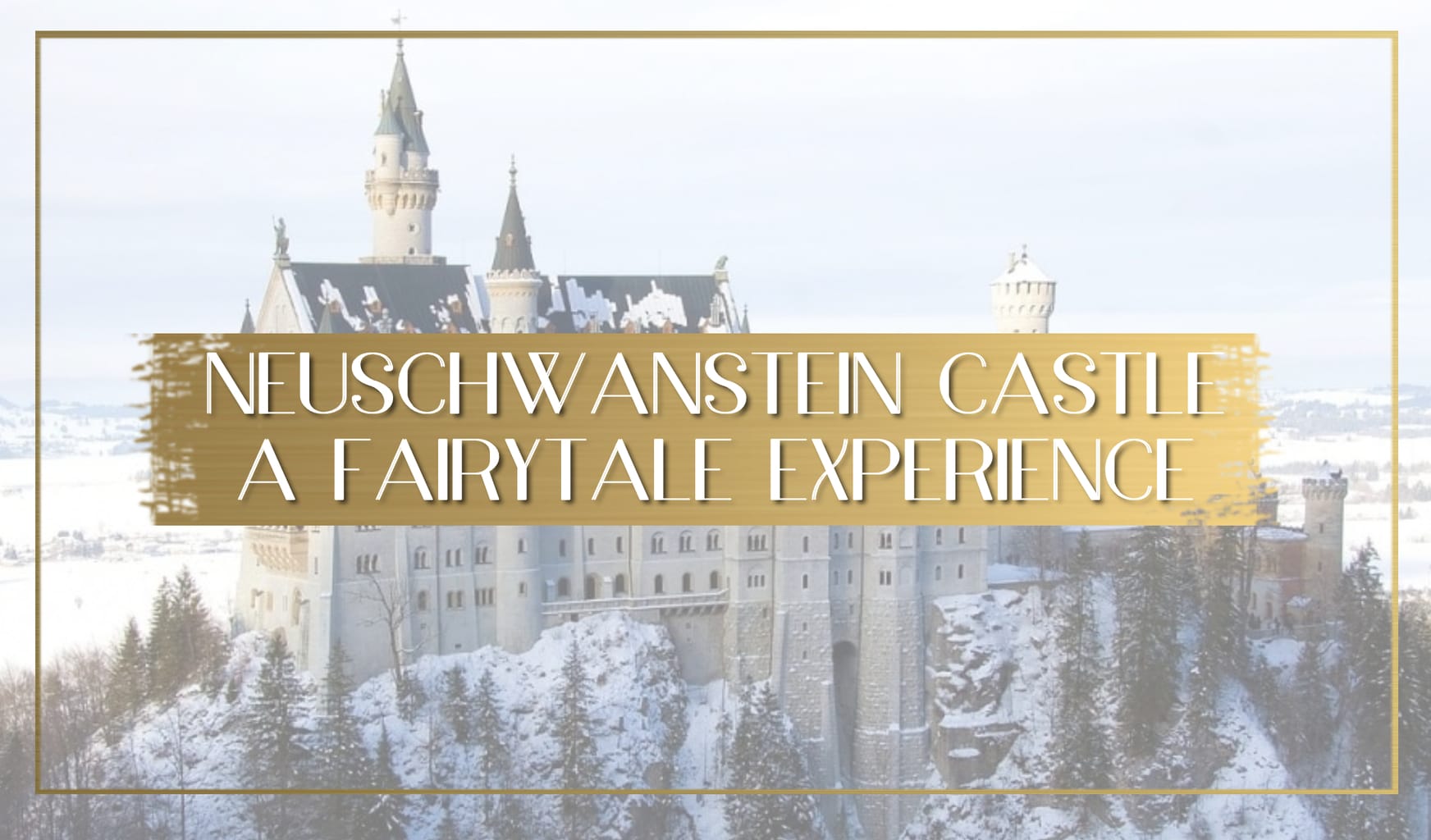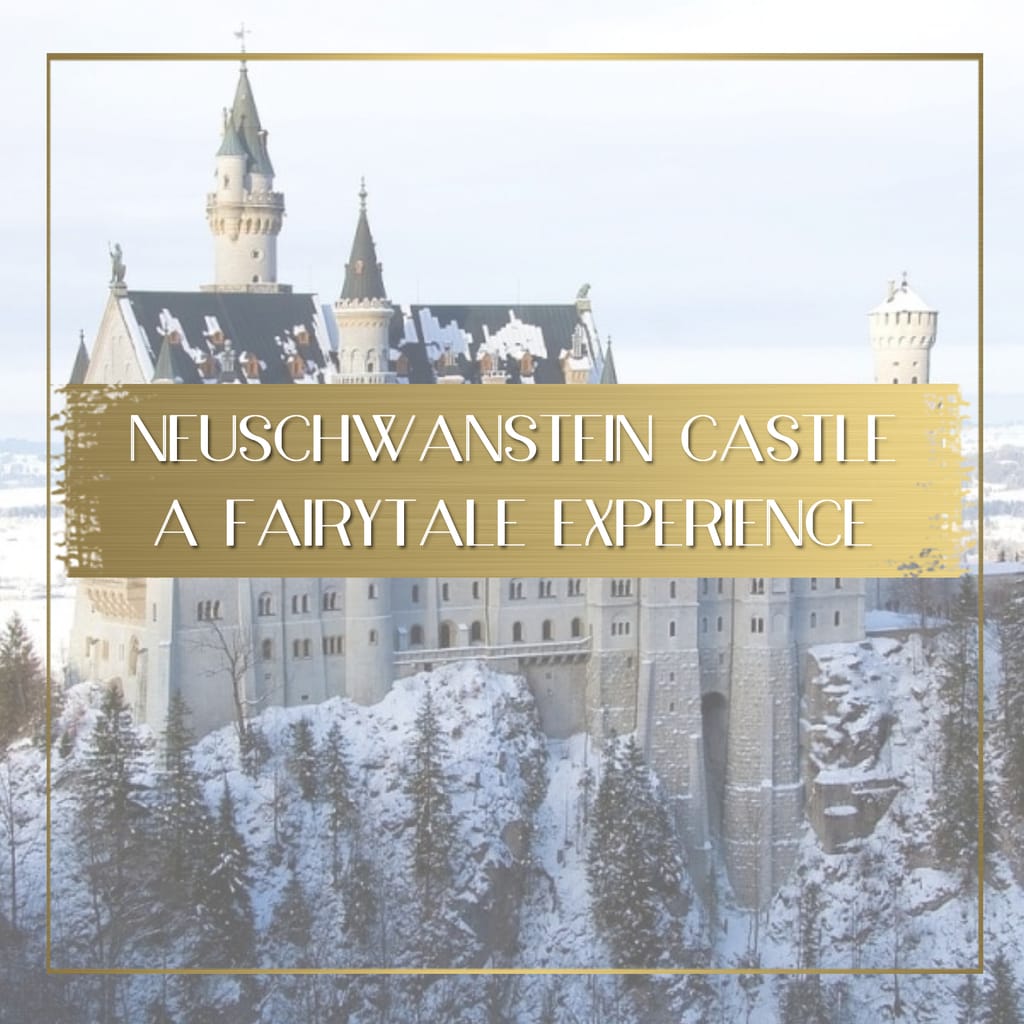
The irony of historical places is that they are often seen as vastly different from their original intended purpose. This is the case for Neuschwanstein Castle built by Bavarian King Ludwig II to withdraw from the public life.
Today, the fairytale castle is one of the most famous and popular castles in Europe receiving 1.4 million visitors a year and one of the most beautiful places in Germany. In the busier summer months, up to 6,000 visitors can walk through the hills and rooms of the castle, making it almost 800 per hour. Most people will know Neuschwanstein Castle as Cinderella’s real life castle. It’s a perfect pit-stop if you’re on an epic road trip across Europe.
Why is Neuschwanstein Castle so popular?
I will admit it. I had never been to Germany until the Christmas of 2016, it was one of many European countries I had purposely avoided, “I’ll go when I move back to Europe”. Hence, I had little information about the country but, as soon as I searched for things to do from Munich, the castle came up, as did the city’s Christmas market, one of the best Christmas markets in Germany.
Because of how magical and romantic it looks, Neuschwanstein Castle was the inspiration for Disney’s Cinderella castle. The replica in Disney World mimics the castle’s towering pointy roofs and round towers. As kids, when we would read Medieval love stories or Spanish classic writers, with princesses locked up in castles, Neuschwanstein Castle is the image we all had in our heads. It was also the image Kind Ludwig II had to, for he designed the castle to look like his fairytale dreams.
But behind the Medieval look of the castle lies the modern technology of the 19th century. The foundations and structures were built using steel and advanced tools to ensure the castle’s resilience to the tough weather and the precarious location, perched on top of a steep hill on the side of a mountain.
With so much magic and romance, it is no wonder that hordes of people descend on this pretty architectural masterpiece to see what being a princess would have felt like.
The story of Neuschwanstein Castle
The castle was never finished during King Ludwig’s II lifetime and he only ever saw it as a construction site. Some parts of the castle were never completed and, after his death, the castle was opened to the public as-is.
The views from the castle over the plains and lake are impressive. The interior, which can only be visited by booking a guided tour, is a world of fairytales and fantasy created from the same legends that inspired Wagner’s operas, the musician King Ludwig II dedicated the castle to. He said to Wagner:
It is my intention to rebuild the old castle ruin of Hohenschwangau near the Pöllat Gorge in the authentic style of the old German knights’ castles, and I must confess to you that I am looking forward very much to living there one day (in 3 years); there will be several cosy, habitable guest rooms with a splendid view of the noble Säuling, the mountains of Tyrol and far across the plain; you know the revered guest I would like to accommodate there; the location is one of the most beautiful to be found, holy and unapproachable, a worthy temple for the divine friend who has brought salvation and true blessing to the world. It will also remind you of “Tannhäuser” (Singers’ Hall with a view of the castle in the background), “Lohengrin'” (castle courtyard, open corridor, path to the chapel); this castle will be in every way more beautiful and habitable than Hohenschwangau further down, which is desecrated every year by the prose of my mother; they will take revenge, the desecrated gods, and come to live with Us on the lofty heights, breathing the air of heaven
King Ludwig II
But King Ludwig II did not build the castle just to withdraw and enjoy peace, he was also trying to build the kingdom he had lost in 1866 when Bavaria, lost a war against Prussia. As a result, Bavaria had to accept a “defensive and offensive alliance” with Austria, which removed the king’s right to dispose over his army in case of war. In a nostalgic effort to recoup this lost sovereignty, he started building castles and palaces where he could still feel like a King.
A tour of Neuschwanstein Castle
The castle is made of various rooms including the bedroom, the salon, a singer’s room, the throne hall and the kitchen. All interiors are incredibly decorated leaving no blank space.
The pictures on the walls of most rooms represent scenes of love and guilt, repentance and salvation. The characters are taken from Medieval legends and sagas. Kings and knights, poets and lovers fill the rooms. There are three main figures: the poet Tannhäuser, the swan knight Lohengrin and his father, the Grail King Parzival (Parsifal) who Ludwig identified himself with since childhood. A swan appears frequently. The swan was the heraldic animal of the Counts of Schwangau, whose successor the king considered himself to be. It is also the Christian symbol of the “purity” for which Ludwig strived.
In the throne hall the paintings show how Ludwig saw kingship “by the Grace of God”: as a holy mission, with powers that the Bavarian king had never possessed. The Throne Hall is incredibly ornate and combines politics and religion in the same room with both a church and a throne. The room was inspired by the Byzantine churches like the All Saints Court Church in Munich. The throne was supposed to be where the altar is but after the King died it was never built.
Most of the walls of the castle are painted with intricate, colorful and incredibly detailed stories and fascinating sagas telling stories of love, treason, magical powers, torment, death, sins, betrayal and magic. Some of the sagas are incredibly fantastic with love potions, magic, superpowers, spirits and impossible love.
The most incredible room is the King’s bedroom which is painted, decorated, carved and embroidered in full. The room presents the unfathomable love story of Tristan and Isolde with murals, sculptures and even carvings of the two characters in various places in the room. Many of the rooms feature velvet, silk and gold embroidered fabrics. The rooms are ostentatiously regal and kingly, the type of wealthy and extravagant living kings must have lived in.
Despite the look and feel and like with the rest of the construction, the interiors feature plenty of nods to modern comforts. There are lifts to carry the food upstairs, electrical bells to summon the servants, comfortable central heating and other modern facilities. The Medieval feeling of the castle is only an appearance, a magical world created by King Ludwig II.
Practicalities
The castle is an incredibly popular place, book your tour ahead to avoid disappointment. I arrived in the dead of winter and found incredible queues despite being the low season. Tours run every 5 minutes and can be booked there but I would discourage you from doing this because even in the quieter months the wait could be 2-3hours, book online instead. Tickets for the guided tour are 12 euro. The castle opens from 10am to 5pm every day.
If you don’t join a tour of the interiors, visiting the castle exteriors is free. You can either walk up the hill for 30min or take a horse drawn carriage or a bus that runs every 20min. The bus stops just up the road from the tourist center and costs 1,8 euro to go up and 1 euro to come down. It is best you take it on the way up, the road is very steep, and walk down through the windy pleasant road.
The best views from the outside can be found from the platform hanging on the abyss just to the right of the castle when facing the main entrance. The are toilets by the entrance.
Photos of the interiors courtesy of Neuschwanstein Castle’s website
